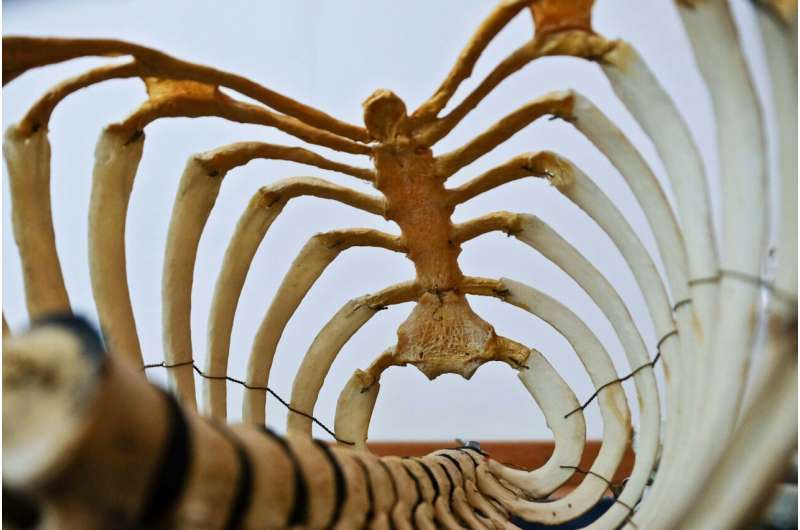This article has been reviewed according to Science X's editorial process and policies. Editors have highlighted the following attributes while ensuring the content's credibility:
fact-checked
trusted source
written by researcher(s)
proofread
Kidneys, ribs and even testicles: The extra body parts you might not know you have

Thanks to millions of years of evolution, the human body has become well versed in its developmental processes. Most of the time, it gives us the correct number of organs and structures that we need to function. But sometimes, hiccups in this process mean people end up with extras.
Accessory teeth, fingers, toes and nipples are actually surprisingly common.
Up to 1% of the population are born with extra fingers or toes, while around 1% of people are born with additional teeth. Both of these phenomena are more common in men—particularly extra digits, which are twice as common in males.
Approximately 6% of people have an extra nipple. These can appear anywhere along the line that runs from the armpit to the groin—known as the mammary ridges or milk lines. As with extra teeth and digits, supernumerary nipples are more common in men, but it's unclear why. They also tend to appear on the left side of the body.
But these aren't the only places that extra body parts can appear. Some people are born with extra bones, organs or genitalia they might not even be aware they have.
Ribs
Supernumerary ribs are typically seen in two places: the neck or the lumbar region (lower back). An estimated 1% of the population has an extra rib—though when it comes to an extra neck rib, it could actually be closer to 4.5%. The extra rib can occur on one or both sides of the spine.
An extra rib usually causes no problems and is only discovered incidentally during an X-ray or imaging for another condition—although it can cause harm if it compresses neighboring nerves and blood vessels.
If this happens in the neck, it may cause pain, numbness and tingling in the arms. In the lumbar region, additional ribs can cause back pain.
Abdominal organs
An extra spleen is surprisingly common. Between 19% and 30% of people have an accessory spleen.
They're typically found near the main spleen—but in some circumstances can be dragged down into the pelvis. Accessory spleens can present clinical challenges if they need to be surgically removed in the treatment of hemolytic anemia, where red blood cells are destroyed faster than they can be made.
The liver is the abdomen's largest organ, comprising four different parts (lobes). Less than 1% of people are reported to be born with an accessory lobe of the liver—though this number could be higher, as having an accessory lobe usually causes zero symptoms. Most people who have an additional liver lobe only discover it incidentally—either during surgery or imaging for a different condition.
But there are cases of the accessory lobe causing a torsion following blunt force trauma. This cuts off the blood supply and requires emergency surgery.
Supernumerary kidneys can also occur—though this is incredibly rare, with less than 100 reported cases on record. Again, this may be because they tend not to cause any health problems. There's also the rarest-of-the-rare: a recent baby was born with two supernumerary kidneys, making four in total.
What is more common, however, is having a duplex kidney—where there's an additional tube coming from the kidney that connects the bladder. Up to 6% of the population has one.
Genitalia
There are multiple genital anomalies that can happen. This is due to the fact that the testes and ovaries develop on either side of the body, making it possible for supporting structures to fuse incompletely during normal development, causing supernumerary genitalia to form.
Double uteri happens in about 0.3% of women, a very rare occurrence. Each uterus can have its own cervix and vagina (or may share a vagina). Each uterus is usually capable of carrying a healthy fetus at the same time—though a double uterus has been associated with higher risk of miscarriage, preterm delivery, breech delivery and stillbirth.
Additional ovaries can also happen in rare cases. Often, these are found much higher up in the abdomen or around the kidneys, where they can become tumors.
Men can also be born with additional genitalia. Diphallia refers to being born with two penises—a phenomenon which occurs in one in every 5 million to 6 million births. Each case is unique, with varying size, shape and functionality.
Recently, it was even reported a child had been born with three penises (triphalia)—although only one had all the necessary tubes to urinate.
Supernumerary testicles (polyorchidism) may also be seen, with three being the most common anomaly—with the extra one usually being present on the left side. Throughout history, there have only been seven reported cases of a person being born with four testicles. Additional testicles do not cause issues unless they haven't descended into the scrotum, which is associated with an increased risk of testicular cancer.
Double bladders are an incredibly rare duplication, with only 50 known cases.
Extra limbs
Additional limbs (polymelia) are one of the rarest supernumerary structures seen in humans. This happens in the upper limbs almost six times more often than the lower limbs.
In the upper body, these accessory limbs tend to grow from the shoulder, while in the lower body additional legs tend to grow from the pelvis. Extra feet can also occur.
In even rarer circumstances, an additional limb can grown from the middle of the back—known as "notomelia". But rarest of all is "cephalomelia"—where an infant is born with limbs growing from the head. In these cases, surgery will be required to remove the extra limb.
Supernumerary structures of all kinds typically don't cause any harm to our health. In many cases, they're just another thing that makes each human unique.
This article is republished from The Conversation under a Creative Commons license. Read the original article.![]()





















